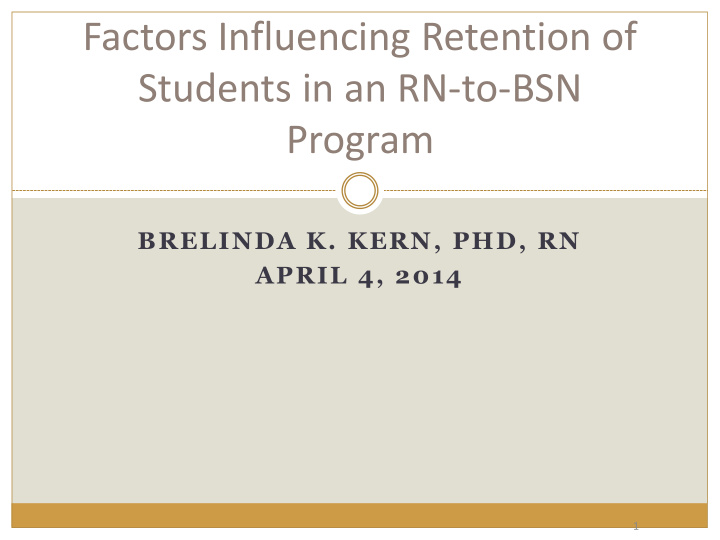



Factors Influencing Retention of Students in an RN-to-BSN Program BRELINDA K. KERN, PHD, RN APRIL 4, 2014 1
Problem 2 Justification Retention a benchmark for program success Schools must identify reasons RN-to-BSN program students leave Little to no evidence of studies Significance RN-to-BSN enrollment up; attrition rates +50% Retention tracked; More data needed 80% of nurses should have BSN by 2020 ( ANA, 2008 & IOM, 2011) Bre Kern
Purpose 3 Describe factors that restricted or promoted retention among RN-to-BSN students Examine any difference in the measure of these factors between juniors and seniors Ultimate goal to inform faculty Develop and guide interventions Assist universities to meet nursing organization suggestions Bre Kern
Theoretical Basis 4 Philosophical underpinnings – Comte ’ s positivism concept Goal of knowledge is only to describe the phenomena Conceptual framework Jeffreys (2004) N ursing U ndergraduate R etention and S uccess (NURS) model; Focus on retention Bre Kern
Review of Literature 5 Few studies among RN-to-BSN students Persistence, minority retention, and online orientation Direct interaction of faculty & students a constant theme Faculty availability and timely feedback most important Jeffreys – extensive research Identified five factors that restrict/support student retention Environmental factors Institutional interaction and integration factors Personal academic factors College facilities factors Friend support factors Bre Kern
Methodology 6 Research design Non-experimental, descriptive, comparison study, using convenience sample from RN-to-BSN students at one liberal arts university Instrumentation SPA-R and demographic questionnaire Reliability and validity Protection of human subjects – IRB approval Bre Kern
Study Setting 7 Midwest liberal arts university Two main campuses in separate states Learning environment Face-to-face and blended Geographically separated sites Learning cohorts Community hospitals and community colleges Bre Kern
Overview of Results 8 Invitation sent to 208 individuals 84 (40.38%) entered survey site The sample White females, mid-30 ’ s, married, full-time jobs Continuously enrolled with average grade of A Bre Kern
Research Questions 9 Question 1 – What are the descriptive values for five identified factors among a sample of RN-to-BSN students? Question 2 – What is the rank order of the means of the scores for the measures associated with each of the five factors among this sampling? Bre Kern
Descriptive Statistics for the Scores of the Research Variables (N = 77) 10 ________________________________________________________________________ Variable M SD range n ________________________________________________________________________ Environmental factors .23 .46 -.80 to 1.40 77 College facilities factors .25 .27 -.40 to .80 76 Personal academic factors .29 .72 -1.20 to 2.00 77 Institutional integration factors .33 .32 -.40 to 1.20 77 Friend support factors 1.23 .61 .00 to 2.00 77 ________________________________________________________________________ Bre Kern
Integration of Findings with Literature 11 Environmental Factors Least supportive factor; Congruent with Jeffreys (2007) Institutional Interaction & Integration Factors Congruent with Jeffreys ’ (2004, 2007) studies; Active mentoring by faculty seen as most beneficial Personal Academic Factors Congruent with Jeffreys (2007) Students challenged to balance responsibilities Able to prioritize; Skill used daily in nursing practice Bre Kern
Integration of Findings with Literature (Cont’d) 12 College Facilities Factors Not perceived as most restrictive or supportive Differences encountered in current study Friend Support Factors Perceived as most supportive Support of family and friends linked to retention Differences encountered in current study None; Seen by juniors and seniors as key to staying in program Bre Kern
Implication of Findings 13 Nursing Education Study focused on infrequently studied students; Sensitize faculty to supportive and restrictive factors Nursing Practice More emphasis needed on strategies other than financial aid Nursing Research Low retention rates in degree completion programs (AACN, 2010) Retention likely to lead to advanced nursing education Bre Kern
Limitations 14 Testing and instrumentation Low inter-item reliability Survey items not specific Generalizability One population Small sample size Bre Kern
Recommendations For Future Studies 15 Qualitative study Mixed methods study Revise tool to be specific to RN-to-BSN students Increase sample size and/or calculate power analysis for a large effect size Bre Kern
Questions 16 ? Bre Kern
Recommend
More recommend